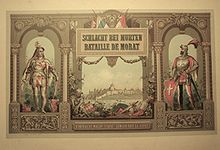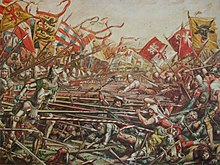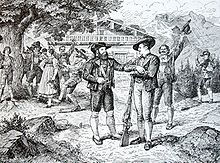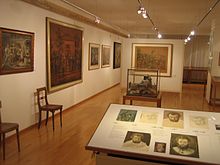Karl Jauslin
Karl Jauslin (born May 21, 1842 in Muttenz , Canton Basel-Landschaft , Switzerland; † October 12, 1904 ibid) was a Swiss painter and illustrator. He is best known as a history painter .
Life

Karl Jauslin was born as the first child of Johannes and Maria Jauslin-Leupin. His younger sisters were Emma (born 1843), Lina (1853) and Bertha (1855). The father first worked as a worker in a quarry, then as a farmhand with his father-in-law and finally joined the cantonal police force. The father's frequently changing places of work meant that the family often had to change their place of residence.
In addition to history and geography, drawing was Jauslin's favorite subject at school. The numerous surviving leaves from his childhood show that he was particularly fond of the heroes from Swiss history such as Wilhelm Tell or Arnold von Winkelried , and that he often drew kings, freedom fighters and soldiers. He also drew motifs from his surroundings based on nature or caricatured his teachers or classmates.
After the death of his father in 1858, the family entered a period of great poverty. Jauslin had to work as a handyman on construction sites, but for health reasons he switched to Achilles Alioth's Schappess spinning mill in Dornach . In his autobiography Jauslin writes: ... I went there with pain because I could no longer draw, because that was my all. O the cruelly lost time of yesteryear! I endured this agony for two years, then I ran away. ... Again I went to Major Alioth and complained to him of my distress, showed him my drawings and paintings, what I still had, because I had thrown most of them into the oven out of desperation. Mr. Alioth took pity on me and I started an apprenticeship in Basel with decorative painter Thommen ...
Jauslin worked for eight years as a decorative painter in Bernhard Thommens (1826–1868) prosperous company with up to 30 employees . Alioth paid the hardship in the opinion that Jauslin was being trained as a painter. Jauslin had to provide him with a picture from time to time to show his progress, although he was not given appropriate instruction. In addition, he attended evening courses at the Basel School of Drawing and Modeling, where he obtained several diplomas. Only a few works by Jauslin have survived from this time.
From his free time, however, some drawings and watercolors have been preserved, as well as a small-format sketchbook with 58 sheets from 1868, in which Jauslin had recorded what moved him. One of the self-portraits shows him sitting lonely and sadly at the edge of the forest. Jauslin himself describes his state of mind at that time as "unspeakably wistful". That his girlfriend emigrated to America with her family certainly contributed to this. The grief over this followed Jauslin for years and was the reason why he remained single.
After Thommen's death in 1868, Jauslin spent two years painting stove tiles and blinds and tried unsuccessfully to sell his pictures. After the outbreak of the Franco-Prussian War , the Stuttgart publisher Eduard Hallberger hired him in 1870 as an illustrator of war scenes for the family magazine Über Land und Meer . For current war reporting it was customary for the illustrators to supply the corresponding drawings for the written reports, which at the same time had to obey formal artistic aspects. On behalf of the publisher, Jauslin visited the hospital in Karlsruhe, the bombardment of Strasbourg, the siege of Belfort and the entry of the Bourbaki army in Les Verrières . The orders helped Jauslin to travel to Germany and Switzerland.
In spring 1871, the 29-year-old Jauslin began studying at the Royal Art School in Stuttgart . For four years he took lessons in painting, engraving , etching , perspective drawing and modeling. He also attended lectures on art history with Wilhelm Lübke . Jauslin earned his studies by continuing to work for the Hallberger Verlag. He was also supported by his mother and sisters.
Jauslin received several diplomas and prizes for his work. He turned down an offer for a scholarship from the Canton of Baselland, as it was linked to the obligation to later serve as a drawing teacher. Most of the drawings have survived from this period; Nude studies and drawings "after antiquity" as well as drawings of horses. In November Jauslin traveled to Vienna, where he studied the work of the old masters such as Breughel , Dürer or Rubens as well as the Italian masters. At the academy attended classes in costume studies. In the hospital he drew anatomical representations for publications by the doctor Salomon Stricker .
In the spring of 1876 Jauslin returned to Switzerland, to Muttenz, where he lived with his mother and sisters. His sister Bertha married and emigrated to America with her husband. In 1886 the Jauslins at Wartenberg on Burggasse in Muttenz were able to acquire a small house where the artist lived until his death. Apart from a few short trips, his life was outwardly calm. In September 1904 Jauslin suffered a stroke after a parade in which he had participated as a standard bearer in historical uniform, of which he died two weeks later. His house no longer stands today; but a memorial stone reminds of him. Another street in Muttenz is named after Karl Jauslin.
Works
Pageants
The celebration of the 400th anniversary of the Battle of Murten in 1876 prompted Jauslin to leave Vienna and return home. The Bern publisher Rudolf Buri, for whom Jauslin had already carried out orders, commissioned him to draw the pageant in Murten.
Pageants were very popular in the 19th century and their design required great knowledge of costume and weapons. Since the 1870s there have been folders on the cultural history of European and foreign peoples and illustrated sheets show the art history of numerous countries and epochs. Over the years, Jauslin acquired a large library of such reference works.
A parade draftsman had to put the characters in groups together, along with their equipment and costumes. Then the individual groups were drawn in the correct order. Every participant in the procession wanted to see themselves represented in the printed illustration that was published before the festival. Jauslin's depiction of the train appeared as an 8.5-meter-long leporello , which was published in 1877 by Buri & Jeker in Bern as a large-format “splendid edition” in 40 color lithographs . The templates came in equal parts from Jauslin and Gustav Roux (1828–1885).
The Murten Festival made Jauslin widely known, brought him into contact with well-known illustrators and was the prelude to his work as a designer and draftsman of festival parades. In Jauslin's estate there are over 1000 sheets with costume sketches. Jauslin himself owned several historical uniforms, armor and weapons as well as a jointed doll that he could put on and use as a model.
Among other things, Jauslin draws the parades for Bern (1882), the Kleinbasler Jugendfest (1883), Schaffhausen (1885), the festival album for the Sempach battle celebration (1886), more than a dozen parades for the Basel Carnival and in 1888, 1891 and 1894 the Zurich Sechseläuten . It was a particular honor for Jauslin to be able to draw the move to open the Swiss National Museum in 1898 . Most of the illustrations appeared as series pictures on large sheets, two of them as leporello.
Every now and then Jauslin marched with the parades himself in costumes. His tall figure and flowing beard corresponded exactly to the image that people then made of their heroic ancestors.
calendar
Jauslin drew for twelve different folk calendars , which were an important source of clear information for many people. He received his first commission in 1874 from Buri & Jeker, who published the Swiss Miniature Almanac for the first time that year. Around 400 pencil sketches for calendar texts have been preserved. The images were reversed and transferred to a wooden printing block by a xylograph . The quality of the printed images largely depended on the engraver, who had to work out the details in three dimensions in order to achieve a spatial effect.
Picture sheets and book illustrations
In 1874 the Buri & Jeker publishing house in Bern published the first sheets of the Swiss Illustrated Sheet . Most of the drawings for the 24 sheets were made by Jauslin. With the “Bilderbogen” the editors wanted to create a popular series that was already available in other countries. The images were all related to Switzerland and showed historical moments and scenes from popular life. However, the picture sheets did not sell as expected and, to Jauslin's great disappointment, were discontinued after 24 issues.
Since around 1885, a publication in which Jauslin participated has appeared almost annually, such as the series Illustrirte Schweizergeschichte by the Zurich publisher JR Müller, for which Jauslin also illustrated the calendar cousin Jakob . He also illustrated, among other things, the book Pictures from the Basler Familienleben by Emma Kron in 1882 , the dialect poems of the Basel writer Albertine Nüsseler in 1893, the children's book by H. Herzog in 1898 and Hohentwiel and Ekkehard by Karl Weiss in 1901 .
«Pictures from Swiss history»
The pictures from Swiss history are probably Jauslin's most popular and widespread works. They appeared in different versions:
Müller-Landsmann series (1885–1889)
On behalf of the Lotzwil chicory manufacturer Jakob Müller-Landsmann (1852–1905), Jauslin created the first series of pen lithographs with 40 sheets from Swiss history , which were printed in 1886 by Völlmy in Basel. The 72 sheets in series of 12 were printed on cheap paper and had only a title, no text. In 1889 an extended edition with 60 sheets followed, this time with a short accompanying text.
A short accompanying text in German and French was part of a third edition. The series begins with the « pile dwellers » and ends with the Battle of Laupen in 1339. History and legend are mixed up in a colorful mix, without any mention. The pictures served the factory owner as promotional gifts and are among the first evidence of this advertising practice.
Birkhäuser series (1887–1928)
Starting in 1889, Jauslin drew a second large series of pictures from Swiss history for the Birkhäuser Verlag in Basel. Four editions were published:
- 1st edition 1897: 84 sheets in the format 27 × 36 cm, printed on cardboard, format 43 × 51 cm. Text in German and French separately.
- 2nd edition 1900: 90 sheets in the format 33 × 44 cm, printed on cardboard, format 53 × 64 cm. Text in German and French separately.
- 3rd edition 1908: 110 sheets in the format of 15 × 20 cm, text and pictures bound together.
- 4th edition 1928: 112 sheets by Jauslin and 2 sheets by Otto Plattner in the format of 27 × 36 cm, printed on cardboard, format 43 × 51 cm. Text and images bound together.
The texts came from the Basel high school teacher Rudolf Hotz (1852-1917). The Birkhauser prints were printed as phototypes . The print was made directly from the original with watercolors, the quality of which was taken over undiminished. There are no longer any templates.
The Birkhäuser series begins with the “cave dwellers” and ends in 1871 when the Bourbaki army entered Switzerland. About half is the description of battles, fights, raids and sieges. Numerous founding cities and castles are also shown, as well as individual personalities such as Queen Bertha or Rudolf von Habsburg. Themes from the world of legends are also presented, such as Kuno von Hohenraestien or Heinrich von Winkelried's fight with the dragon.
The images corresponded to the then widespread idea of history as a sequence of armed events. They show a preference for numerous figures and dramatic movements. The depicted people move with unmistakable facial expressions and pathetic gestures. They were intended as wall decorations in schools and public buildings and private rooms and fulfilled the desire of the population for patriotic images. They enjoyed great popularity, saw multiple editions and were also published in newspapers and calendars.
Kuno of High Council
Raid at Falkenstein
The murder of Zwingli
The siege of Solothurn
Advertising and wall decorations
Jauslin drew several advertising posters, for example for his sponsor, the chicory manufacturer Müller-Landsmann, or for ink from the Siegwart company in Schweizerhalle . He also designed posters for various official occasions such as the Swiss Federal Shooting Festival, the foundation ceremony in Bern, folk plays and advertising pictures for various companies.
A large-scale illustration showed the workforce of the Moos'schen Eisenwerke Lucerne as entourage and rearguard at the Sempach battle celebration of 1886. In addition to the director Heinrich Meier (1838–1912) and several dignitaries, Jauslin also held on to himself as a handsome man in a frock coat and Walking stick. Based on photographic templates, a color lithograph was created in 1889 with the Swiss General Staff showing the officers on horseback. A four-part series of images on the life of Christopher Columbus was created in 1890 for export .
painting
Jauslin's wish to work as a painter was not fulfilled; he earned his living as an illustrator. That is why Jauslin painted very little in oil, more often he used tempera paints . Two large-format oil paintings have survived : Würsch am Stanserhorn from 1886, a representation from the Nidwalden struggle for freedom, and the undated The old Swiss drank one more before they went into battle .
In 1877 he took part in the competition to paint the Tell Chapel on Lake Lucerne ; However, the contract was awarded to Ernst Stückelberg .
Jauslin liked to paint with watercolors . His pictures include, on the one hand, depictions in which the colors are conventionally applied next to each other, and on the other, in which the colors flow into one another. The mostly small-format pictures show not only interesting views of castles and palaces, but also inconspicuous representations such as the leaves of a tree, clouds or stones on a river bank. However, these representations were hardly known to the public.
Pub pictures
In Muttenz, Jauslin adorned two inns with his pictures: for the "Bierhalle", his regular pub, Jauslin painted a Bacchus and Der Abzug des Ramsteiner . He often painted this motif because the living members of the Ramstein family liked it very much. Here, too, Jauslin had portrayed himself: laughing, he turned his head over his shoulder and toasted the viewer.
Images for military history museums
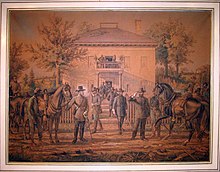
Between 1901 and 1904 he created two series of large-format history pictures for museums. The first series comprised sixteen pictures and was intended for the International War and Peace Museum in Lucerne, which opened in 1902, the second series comprised eight pictures and was shown in the "War Museum" at the World Exhibition in St. Louis (USA) in 1904 . The orders for both series came from Aargau doctor and military historian Heinrich Bircher.
Various works
When medieval frescoes were discovered during the renovation of the fortified church of St. Arbogast in Muttenz in 1880/1881 , Jauslin was commissioned to trace them and restore the depiction of the Last Judgment, which he did by painting over it. In addition, he made miniaturized images of various scenes.
The works that were not intended for the public included around 50 pencil sketches by Muttenz contemporaries, which he often portrayed in the tavern.
Jauslin as a poet
In Jauslin's estate there were around 200 sheets of poetry in which he recorded events in linguistic form, including a popular play entitled The Battle of St. Jacob . The earliest poems date from 1859: the 17-year-old Jauslin then filled 216 pages of a booklet with his poems. His linguistic means of expression were and remained limited later. The final syllables rhymed more badly than right; the meter was observed, but not really mastered. Jauslin also often wrote letters to friends in verse.
Jauslin as an artist
Jauslin was a loner all his life. Even if he met his friends in Muttenz on Saturday evenings in the pub, he lacked the connection to an intellectually and artistically competent friend from whom he could have received criticism or suggestions.
In contrast to most artists of his time, he never joined an artistic circle, nor did he advocate an art theory. Neither in his painting technique nor in his artistic conception was he committed to one direction. An artistic development can hardly be seen in his work. He had never been in a teacher-student relationship and learned mainly from books. The history of art was known to him mainly from black and white reproductions and so the color scheme hardly played a role in his works.
The physiognomies of the people portrayed appear stereotypical, Jauslin was not a portraitist. In contrast to other history painters, he did not work with models, but with representations from his extensive library.
Karl Jauslin Collection
After Jauslin's death, his artistic estate was administered by his sister Lina until her death in 1948. She bequeathed it to the Muttenz community in the 1930s on the condition that her brother's work be made accessible to the public. After Lina Jauslin's death, the estate was kept in the basement of the parish hall for a long time. With the establishment of the local museum in 1972, the set condition was met and a large room in the attic was dedicated to Jauslin's work.
Hildegard Gantner-Schlee was the curator of this collection from 1976 to 2014. She created an inventory in which each object was entered with a number and a name. By far the largest part make up pencil drawings, especially illustrations for folk calendars, brochures and books.
In 2011–2014 the collection was digitized. The database contains over 5000 entries.
The completely redesigned exhibition in the Muttenz local museum opened in August 2014. Jauslin's pictures are always in demand as book illustrations and originals are loaned for exhibitions at home and abroad.
literature
- Hildegard Gantner-Schlee: Karls Jauslin, history painter and illustrator. Separately printed from Baselbieter Heimatblätter, No. 4, 1979. Verlag Landschäftler, Liestal 1979.
- Hildegard Gantner Schlee: Karl Jauslin's illustrations on Swiss history. Special publication of the Swiss Academy of Humanities SAHS. University Press Freiburg, Freiburg i. Üe. 1987.
- Karl Jauslin: A picture of life told by himself. Published in: Vom Jura zum Schwarzwald, Volume 7, 1890.
Web links
- Karl Jauslin's estate in the Basel University Library
- Literature by and about Karl Jauslin in the catalog of the German National Library
- Tapan Bhattacharya: Jauslin, Karl. In: Historical Lexicon of Switzerland .
- Jauslin, Karl. In: Sikart
- Jauslin, Karl. In: Personal Lexicon of the Canton of Basel-Landschaft
- Karl Jauslin at Online-Heimatkunde Muttenz
| personal data | |
|---|---|
| SURNAME | Jauslin, Karl |
| BRIEF DESCRIPTION | Swiss history painter |
| DATE OF BIRTH | May 21, 1842 |
| PLACE OF BIRTH | Muttenz , Switzerland |
| DATE OF DEATH | October 12, 1904 |
| Place of death | Muttenz |



